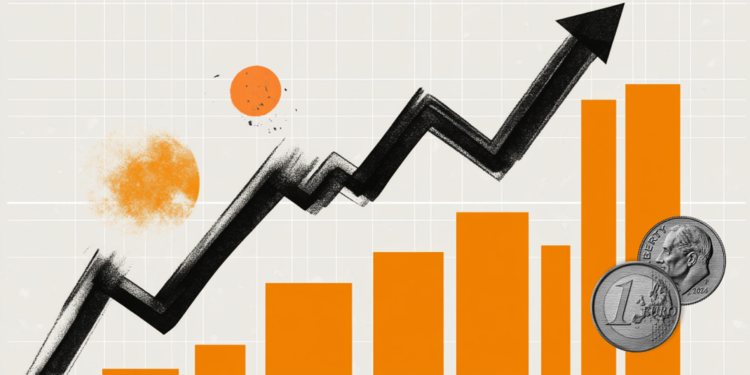- EUR/USD trades at fresh multi-month highs near 1.0800 in the European morning on Thursday.
- The ECB is widely anticipated to lower key rates after March policy meeting.
- The pair remains technically overbought in the near term.
EUR/USD preserved its bullish momentum and registered impressive gains for the third consecutive day on Wednesday. The pair continues to inch higher in the European morning on Thursday and trades at its highest level since early November above 1.0800.
Euro PRICE This week
The table below shows the percentage change of Euro (EUR) against listed major currencies this week. Euro was the strongest against the US Dollar.
| USD | EUR | GBP | JPY | CAD | AUD | NZD | CHF | |
|---|---|---|---|---|---|---|---|---|
| USD | -4.05% | -2.55% | -1.15% | -0.78% | -2.14% | -2.45% | -1.36% | |
| EUR | 4.05% | 1.45% | 2.80% | 3.21% | 1.89% | 1.48% | 2.61% | |
| GBP | 2.55% | -1.45% | 1.46% | 1.74% | 0.43% | 0.03% | 1.15% | |
| JPY | 1.15% | -2.80% | -1.46% | 0.60% | -0.95% | -1.27% | -0.21% | |
| CAD | 0.78% | -3.21% | -1.74% | -0.60% | -1.21% | -1.68% | -0.58% | |
| AUD | 2.14% | -1.89% | -0.43% | 0.95% | 1.21% | -0.40% | 0.72% | |
| NZD | 2.45% | -1.48% | -0.03% | 1.27% | 1.68% | 0.40% | 1.12% | |
| CHF | 1.36% | -2.61% | -1.15% | 0.21% | 0.58% | -0.72% | -1.12% |
The heat map shows percentage changes of major currencies against each other. The base currency is picked from the left column, while the quote currency is picked from the top row. For example, if you pick the Euro from the left column and move along the horizontal line to the US Dollar, the percentage change displayed in the box will represent EUR (base)/USD (quote).
The US Dollar (USD) remained under heavy selling pressure midweek despite the upbeat ISM Services Purchasing Managers Index (PMI) report for February. News of US President Donald Trump granting the US automative industry a one-month exemption from 25% tariffs imposed on Canada and Mexico allowed the risk mood to improve and forced the USD to continue to weaken.
Later in the day, the European Central Bank (ECB) will announce monetary policy decisions and publish the revised macroeconomic projections. Markets widely expect the ECB to lower key rates by 25 basis points (bps).
A downward revision to inflation and growth expectations could cause investors to price in a continuation of policy easing and open the door for the Euro to correct lower. Market participants will also pay close attention to comments from ECB President Christine Lagarde. In case Lagarde adopts a cautious tone on additional rate cuts, citing the uncertainty surrounding the EU-US trade relations, the Euro could hold its ground.
The US economic calendar will feature the weekly Initial Jobless Claims data. Investors, however, could ignore this data ahead of Friday’s Nonfarm Payrolls (NFP) report.
EUR/USD Technical Analysis
The Relative Strength Index (RSI) indicator on the 4-hour chart climbed above 80, reflecting extremely overbought conditions for EUR/USD in the near term. On a bullish note, the pair made a daily close above the 200-day Simple Moving Average (SMA), currently located at 1.0720, for the first time in four months.
On the downside, 1.0760 (static level) aligns as interim support before 1.0720 (200-day SMA) and 1.0700 (static level, round level). Looking north, first resistance could be spotted at 1.0900 (static level, round level) ahead of 1.0940 (static level from November).
ECB FAQs
The European Central Bank (ECB) in Frankfurt, Germany, is the reserve bank for the Eurozone. The ECB sets interest rates and manages monetary policy for the region. The ECB primary mandate is to maintain price stability, which means keeping inflation at around 2%. Its primary tool for achieving this is by raising or lowering interest rates. Relatively high interest rates will usually result in a stronger Euro and vice versa. The ECB Governing Council makes monetary policy decisions at meetings held eight times a year. Decisions are made by heads of the Eurozone national banks and six permanent members, including the President of the ECB, Christine Lagarde.
In extreme situations, the European Central Bank can enact a policy tool called Quantitative Easing. QE is the process by which the ECB prints Euros and uses them to buy assets – usually government or corporate bonds – from banks and other financial institutions. QE usually results in a weaker Euro. QE is a last resort when simply lowering interest rates is unlikely to achieve the objective of price stability. The ECB used it during the Great Financial Crisis in 2009-11, in 2015 when inflation remained stubbornly low, as well as during the covid pandemic.
Quantitative tightening (QT) is the reverse of QE. It is undertaken after QE when an economic recovery is underway and inflation starts rising. Whilst in QE the European Central Bank (ECB) purchases government and corporate bonds from financial institutions to provide them with liquidity, in QT the ECB stops buying more bonds, and stops reinvesting the principal maturing on the bonds it already holds. It is usually positive (or bullish) for the Euro.

